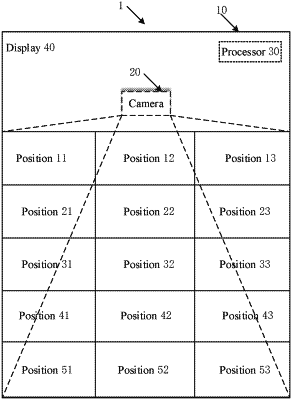| CPC G06Q 10/087 (2013.01) [G06T 7/254 (2017.01)] | 2 Claims |

|
1. A method of determining a first status and a second status of a position on a shelf, the position being operatively configured to accommodate and display an object, the method comprising:
acquiring current detection data of the shelf in a current detection period, wherein the current detection data comprises data of one or more positions on the shelf;
determining whether the current detection data comprises motion data;
in response to determining that the current detection data comprises the motion data, updating time of a last detection period containing the motion data, ending the current detection period, and returning to the step of acquiring the current detection data of the shelf in the current detection period;
in response to determining that the current detection data does not comprise the motion data, acquiring a first time interval between time of the current detection period and the time of the last detection period containing the motion data;
ending the current detection period, and returning to the step of acquiring the current detection data of the shelf in the current detection period, when the first time interval is less than or equal to a first preset time interval;
determining first status information of respective positions from the current detection data, when the first time interval exceeds the first preset time interval, wherein the first status information indicates the first status that there is an object in a position or the second status that there is no object in a position;
in response to the current detection data indicating that a target position whose first status information indicates the first status exists, updating a current status of the target position to the first status, ending the current detection period, and returning to the step of acquiring the current detection data of the shelf in the current detection period;
in response to the current detection data indicating that a target position whose first status information indicates the second status exists, acquiring first status information of the target position from previous detection data in a previous detection period;
in response to the first status information of the target position from the previous detection data indicating the first status, updating the time of the last detection period containing the motion data to the time of the current detection period, determining that second status information of the target position indicates a fourth status that an object is picked up, ending the current detection period, and returning to the step of acquiring the current detection data of the shelf in the current detection period;
in response to the first status information of the target position from the previous detection data indicating the second status, acquiring a second time interval between the time of the current detection period and the time of the last detection period containing the motion data;
determining that the second status information of the target position indicates a third status that an object is out of stock, when the second time interval exceeds a second preset time interval; and
controlling a display of the shelf to display the first status, the third status, or the fourth status of the target position
wherein the current detection data comprises a current frame image collected by a camera; and
determining whether the current detection data comprises the motion data, comprises:
acquiring a difference in grayscale values between the current frame image and a previous frame image at a same pixel;
determining a number of pixels with the difference in grayscale values exceeding a preset grayscale threshold; and
determining that the current frame image comprises the motion data representing a motion relative to the previous frame image, in response to a ratio of the number to a total number of pixels in the current frame image exceeding a preset ratio threshold, otherwise determining that the current frame image does not comprise the motion data.
|